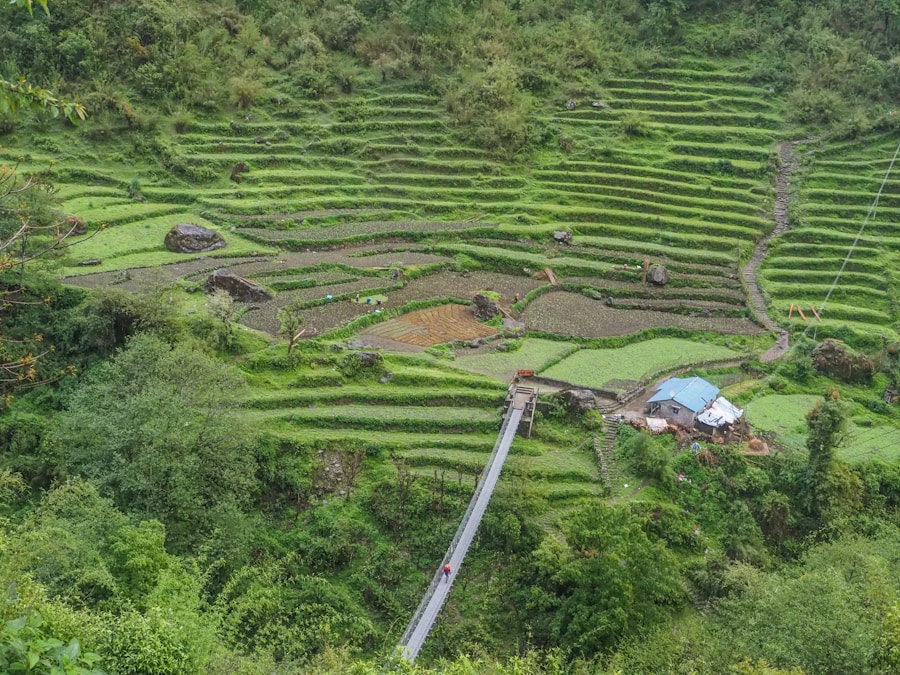Download links
How to install The Majestic Banaue Rice Terraces: A UNESCO World Heritage Site APK?
1. Tap the downloaded The Majestic Banaue Rice Terraces: A UNESCO World Heritage Site APK file.
2. Touch install.
3. Follow the steps on the screen.
Description
Nestled in the mountainous region of the Philippines, the Banaue Rice Terraces are often referred to as the “Eighth Wonder of the World.” This breathtaking landscape, carved into the mountainside over 2,000 years ago, showcases the ingenuity and resilience of the Ifugao people, who have cultivated rice in these terraces for generations. The terraces stretch over 2,000 square kilometers and rise to an elevation of approximately 1,500 meters above sea level, creating a stunning visual tapestry of verdant green fields that cascade down the mountains. The intricate system of irrigation channels and stone walls not only serves agricultural purposes but also reflects a deep connection between the Ifugao culture and their environment.
The Banaue Rice Terraces are more than just a remarkable feat of engineering; they represent a harmonious relationship between humans and nature. The terraces are a testament to sustainable agricultural practices that have been passed down through generations, demonstrating how traditional knowledge can coexist with the natural world. As a UNESCO World Heritage Site since 1995, the terraces have garnered international recognition, drawing visitors from around the globe who seek to witness this extraordinary cultural landscape.
The terraces are not merely a tourist attraction; they embody the spirit and identity of the Ifugao people, making them a vital part of the Philippines’ cultural heritage.
Key Takeaways
- The Banaue Rice Terraces are a UNESCO World Heritage site and are often referred to as the “Eighth Wonder of the World.”
- The terraces were built over 2,000 years ago by the Ifugao people using minimal equipment, mostly by hand, and are still used for farming today.
- The terraces are not only a feat of engineering but also hold great cultural significance for the Ifugao people, who consider them a symbol of their identity and heritage.
- Conservation efforts are underway to preserve the terraces, but challenges such as environmental degradation and population decline in the region pose significant threats.
- Visitors to the Banaue Rice Terraces can experience the unique culture of the Ifugao people, hike through the terraces, and learn about traditional farming practices.
History and significance of the Banaue Rice Terraces
Agricultural Ingenuity
The construction of the terraces required meticulous planning and labor, where they quarried stones from nearby mountains and arranged them to create a series of flat fields. The ingenuity of this system lies not only in its design but also in its ability to harness rainwater and manage irrigation effectively.
Cultural Significance of Rice
Rice is not just a staple food; it holds significant cultural and spiritual importance.
This communal aspect has fostered a strong sense of identity among the Ifugao people, linking them to their ancestors and their land.
Cultural impact of the Banaue Rice Terraces

The cultural significance of the Banaue Rice Terraces extends beyond their agricultural function; they are deeply intertwined with the identity and traditions of the Ifugao people. The terraces are often seen as a living cultural landscape, where every stone and every field tells a story of ancestral wisdom and resilience. Traditional practices such as rice planting rituals, harvest celebrations, and even burial customs are closely linked to the terraces, reinforcing their role as a cultural cornerstone.
The Ifugao people’s relationship with their environment is reflected in their art, music, and oral traditions, all of which celebrate the beauty and bounty of the rice terraces. Moreover, the terraces have become a symbol of Filipino heritage on a global scale. They attract researchers, anthropologists, and tourists who seek to understand the intricate relationship between culture and agriculture.
The preservation of this cultural landscape is crucial not only for maintaining biodiversity but also for sustaining traditional practices that have been passed down through generations. As visitors explore the terraces, they gain insight into the Ifugao way of life, fostering appreciation for indigenous knowledge systems that prioritize sustainability and respect for nature.
Conservation efforts and challenges
| Conservation Efforts | Challenges |
|---|---|
| Protected Areas | Habitat Fragmentation |
| Species Reintroduction | Illegal Wildlife Trade |
| Community-Based Conservation | Climate Change |
| Conservation Education | Human-Wildlife Conflict |
Despite their historical and cultural significance, the Banaue Rice Terraces face numerous challenges that threaten their preservation. Rapid urbanization, climate change, and shifts in agricultural practices have put immense pressure on this ancient landscape. Many young Ifugao individuals are migrating to urban areas in search of better opportunities, leading to a decline in traditional farming practices.
As a result, some terraces have fallen into disrepair, with vegetation overgrowing once-thriving fields. This loss not only affects food security but also jeopardizes the cultural heritage associated with rice cultivation. In response to these challenges, various conservation efforts have been initiated by local communities, government agencies, and non-governmental organizations.
These initiatives aim to promote sustainable agricultural practices while also providing economic incentives for farmers to maintain their ancestral lands. Educational programs have been developed to raise awareness about the importance of preserving the rice terraces, emphasizing their role in biodiversity conservation and cultural heritage. Additionally, ecotourism has emerged as a potential avenue for generating income while fostering appreciation for this unique landscape.
However, balancing tourism with conservation remains a delicate task, as increased foot traffic can lead to environmental degradation if not managed properly.
Visiting the Banaue Rice Terraces
For those seeking to experience the beauty of the Banaue Rice Terraces firsthand, visiting this UNESCO World Heritage Site offers an unforgettable journey into a world where nature and culture intertwine seamlessly. Travelers can explore various viewpoints that provide stunning panoramas of the terraces, such as the famous viewpoint at Bangaan or the more secluded vantage points at Batad. Each location offers its own unique perspective on this agricultural marvel, allowing visitors to appreciate the intricate patterns created by generations of labor.
Engaging with local communities enhances the experience further. Many Ifugao families welcome visitors into their homes, offering insights into traditional farming practices and sharing stories about their culture. Participating in rice planting or harvesting activities provides a hands-on understanding of the labor involved in maintaining these terraces.
Additionally, local guides often lead treks through the surrounding mountains, revealing hidden waterfalls and lush landscapes that complement the beauty of the rice fields. Such interactions foster meaningful connections between visitors and the Ifugao people while promoting cultural exchange.
Future of the Banaue Rice Terraces

Collaborative Partnerships for Sustainable Tourism
Collaborative partnerships between agencies, NGOs, and local communities will be crucial in developing sustainable tourism models that prioritize conservation while providing economic opportunities for residents.
A Brighter Future Ahead
In conclusion, while challenges abound for the Banaue Rice Terraces, there is hope for their future through concerted efforts aimed at preservation and sustainable development. By valuing both cultural heritage and environmental sustainability, it is possible to ensure that this remarkable landscape continues to thrive for generations to come.
FAQs
What are the Banaue Rice Terraces?
The Banaue Rice Terraces are ancient terraces carved into the mountains of Ifugao in the Philippines. They are often referred to as the “Eighth Wonder of the World” and are a UNESCO World Heritage Site.
How were the Banaue Rice Terraces created?
The terraces were hand-carved over 2,000 years ago by the Ifugao people using minimal equipment, mostly using their bare hands and simple tools. The terraces were created to make the mountainous terrain suitable for rice cultivation.
How big are the Banaue Rice Terraces?
The Banaue Rice Terraces cover approximately 10,360 square kilometers of mountainside. They are often referred to as the largest and most well-preserved ancient terraces in the world.
What is the significance of the Banaue Rice Terraces?
The terraces are not only a stunning example of ancient engineering and agricultural practices, but they also hold cultural and historical significance for the Ifugao people. They are a symbol of their rich heritage and traditional farming methods.
Can visitors explore the Banaue Rice Terraces?
Yes, visitors are welcome to explore the Banaue Rice Terraces. There are hiking trails and viewpoints that offer breathtaking views of the terraces and the surrounding mountains. It is important to respect the local customs and environment while visiting.





